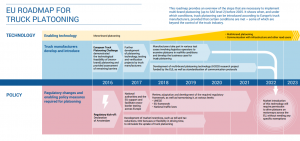The transport industry has changed a lot since Transway Fleet Solutions first began life in the early 1980’s. With the support of our loyal customers we’ve survived and thrived by embracing these changes, and as the industry continues to advance by utilising modern technology such as platooning, we look forward to seeing what the future holds for us and all our customers.
What is truck platooning
Truck platooning is the linking of two or more trucks in convoy, using connectivity technology and automated driving support systems. These vehicles automatically maintain a set, close distance between each other when they are connected for certain parts of a journey, for instance on motorways. The truck at the head of the platoon acts as the leader, with the vehicles behind reacting and adapting to changes in its movement – requiring little to no action from drivers. In the first instance, drivers will remain in control at all times, so they can also decide to leave the platoon and drive independently
What are the benefits of Platooning
Truck platooning holds great potential to make road transport safer, cleaner and more efficient in the future. That’s why truck manufacturers are eager to bring these platoons to Europe’s roads, and the first real-life tests are already underway
CLEAN
- Truck platooning lowers fuel consumption and CO2 emissions. Given that trucks can drive closer together, the air-drag friction is reduced significantly.
- It can reduce CO2 emissions by up to 16% from the trailing vehicles and by up to 8% from the lead vehicle (according to the recent ITS4CV study by Ertico).
- It helps to improve safety. Braking is automatic and immediate; the trucks following the lead vehicle only need one-fifth of the time a human would need to react.
EFFICIENT
- Platooning optimises transport by using roads more effectively, delivering goods faster and reducing traffic jams. The driving range of trucks can also be extended in certain situations.
- It allows drivers to undertake other tasks, such as administrative work or making calls.
Before platoons of trucks can become a common sight on Europe’s roads, we need to:
Further develop platooning technology and relevant standards.
- Upgrade our road infrastructure to allow for platooning.
- Develop a supportive regulatory framework with harmonised rules and exemption procedures.
- Perform joint research projects and showcase activities, for example to test cross-border platooning with multiple brands (a prerequisite for international transport).
Gain more experience with platooning in real-traffic conditions, for example to find out how other road users react to platoons and what the optimal number of vehicles in a convoy is.
- Strengthen cooperation between all relevant stakeholders. This also includes operators of road infrastructure, logistics operators, insurance companies and policy makers.
- Get political support for promoting the wide-spread introduction of platooning, eg through incentives.
The Right Regulatory Framework
In order to bring truck platooning to Europe’s roads in the near future, we will need to build on the political momentum of the Declaration of Amsterdam and implement what we have learnt from the European Truck Platooning Challenge in 2016. Above all, we need to create an enabling regulatory framework at both the EU and international levels. To that end, many changes will need to be made to existing rules and legislation.

Source European Automobile Manufacturers Association
